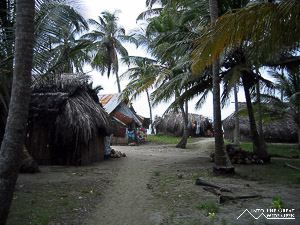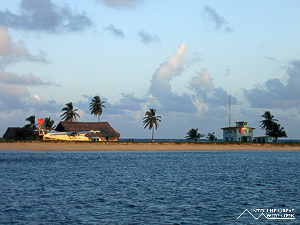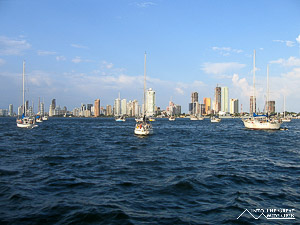San Blas Islands, Panama
In Paradise
December 15, 2007
Though it's cold and lonely in the deep dark night
I can see paradise by the dash board light
- Meat Loaf

With the tortuous sailing trip now partway over, I was reminded that I would never be able to make my living working at sea. On a much brighter note I was greeted by the town of El Porvenir. El Porvenir serves as the capital of this region that includes the San Blas islands and is home to the native Kuna people. The town is unreachable by road and is really the only link that they have to the outside world, well that and the sailboats that ferry tourists right to their doorsteps. The main town is on two islands while a third island has a small hotel/restaurant, an airport, and the immigration and customs facilities. Electricity is only present during the day and early evening and is provided by generators reminding you of their operation with the echoing lawnmower like noises. The airport, if you could call it that, consists of a single strip of concrete which is about 100 yards long and 30 feet wide. The control tower is two stories tall and appears quite limited. When the planes land they come in so low that if you were to stand and the very end of the runway, which is about 30 feet from the water, and put your hand up, the planes would probably hit your hand, if not your head. Surprisingly though there is cell phone service and I took the opportunity to send a text message to alert my parents that I was still alive, albeit barely, but I spared the details as the true story was a bit too long for a text message.

My stomach was still recovering from the rigors of the night before and I dared not eat anything yet save for a packet of crackers to test the waters, so to speak. I was so dehydrated that it took me about ten minutes to eat those four crackers which I washed down sparingly with some water. Sitting on the boat trying to recover I was greeted by a Kuna family paddling their canoe out towards us. It was a statement of stark contrast seeing that Kuna family paddle out in their hand-made canoe around a multi-million dollar yacht to come and try to sell us their crafts. They were selling their famous molas, vibrantly colorful and intricate textiles that are quite striking with their strong designs. They were nice but I thought I would hold out for later. From El Porvenir we sailed across the bay and around a group of islands to a Kuna town called Chichime.

These islands were really the prototypical picture of an island paradise, nothing but sand and palm trees surrounded by crystal clear water of a mesmerizing blue. Bringing the cartoon vision to life, there was even one island about 30 feet in diameter that had nothing but a single palm tree on it. The Kuna people live in thatched houses, fishing and making traditional bracelets, the molas or woven tapestries, and shirts which they sell to tourists to sustain their livelihood. It is very much a simple life, devoid of electricity, and you might ask what else they would need with the plentifully stocked seafood waters all around. The only necessity that is missing is a supply of drinking water which is brought in large plastic drums to make up for the deficiency of what falls is harvested from rainfall. There was evidence of a few other modern conveniences like commercially made clothes and things such as batteries and radios. Some distractions were needed, I mean, could you imagine living your life on an island that you can walk all the way around in 30 minutes? And I thought I grew up in a small town.

The people were very nice to us as we walked around on the islands, and the young kids were really intrigued by our cameras and laughed when we showed them the pictures of themselves in the displays on our digital cameras. Everyone seemed to be bilingual, speaking both Spanish and their native Kuna language. Strangely there were a few dogs on the island and one sad looking monkey which they had tied to a tree. Every so often the dogs would go crazy and try to attack the monkey, and the monkey would shriek and claw at them and run back up his tree just out of reach of the jumping dogs, really a strange and pitiful sight. We were able to procure some fish and crab from the locals and prepared a relative feast that I ate and was able to keep down. The time spent on land and the food had given me a chance to regain some strength, both physical and mental. At this point I was convinced that what I had was no simple bought of seasickness. I had a suspicion that the fish I had eaten in Portobelo had been the source of some kind of food poisoning; the effects of seasickness would have faded much quicker and been less acute. Either way, I was feeling a little better and was eager to get to Colombia.

We spent two nights in the San Blas islands with the last night spent moored at El Porvenir. Because our journey there was so miserable everyone except for myself and the Swiss couple were so traumatized that they had decided to fly back to Panama City rather than continue on to Colombia. I couldn’t understand this decision as I was by far the sickest of anyone and I was continuing on. The Swiss couple and I watched the first and only daily flight land at the airport and unload the passengers and cargo before quickly reloading and then taking off with our former passengers. After purchasing some more gasoline for the boat’s motor and picking up two more passengers we finished preparing for the remaining part of the trip and set sail under much clearer skies.
Thankfully, calmer weather awaited us for the rest of the voyage. After leaving early in the morning we steered away from the coast to cross the stretch of open ocean to Colombia. There were still swells in the ocean but nothing nearly as fierce as what we had faced out of Portobelo. That night, lying on the deck of the boat I looked up at the clear pitch black skies afforded by the new moon to pristine views of the night sky. If you have ever seen the night sky from a remote area then you know just how many stars are out there. From a truly isolated area in total darkness the mosaic of stars is fringed by the diffuse illuminated edges of the Milky Way. This magnificent view in the context of solitude amidst the vast ocean was something unique that I carried with me for the rest of my trip; a reminder of just how insignificant ourselves and our lives can be.

With daylight waning at the end of our second day we finally spotted the outlines of Cartagena in the distance. An hour or two later we were passing high-rise condos and luxury hotels as we slowly drifted into the harbor. We anchored in the harbor but because it was too late the immigration office was closed we were forced to spend another night on the boat. A celebratory dinner and some wine were certainly in order and tasted great, but not nearly as good as a meal on land would have been. At this point though, that was all secondary to the desire to take a shower. It had been five nights at sea and six days under the blazing tropical sun. My skin was layered with salt from the ocean and sweat and covered with sunscreen residue. The only shower I had enjoyed was the occasional downpours of rain which, after our first night, were few and brief. After the ordeal of the sailing trip I needed some recovery time before beginning in earnest my South American odyssey. The trip had tested my resolve and provided moments of doubt and reconsideration but from the deck of the boat the lights of Cartagena emanated a welcoming and uplifting glow.













































